Many years ago, while researching my Henry Ellis Fowler family of Union County, South Carolina, I discovered a man and his family living between documented Fowler households in the 1870 Census.
His name was Emanuel Fowler.
Henry Ellis Fowler (1746-1808) came to Union County from a family of Quakers. The Quakers, although at one time prominent slave traders, were one of the first religious dominations, in 1688, to petition against the practice of slavery and to eventually condemn the enslavement of mankind.
The Henry Ellis Fowler descendants, over time, converted from their Quaker beginnings and became stout Baptists and Methodists. The need for labor in their fields, their new religion, and the widespread acceptance in the South of slavery perhaps eased their minds about the prospect of owning another human being. Some of the Henry Ellis Fowler descendants became slave owners.
Emanuel Fowler was one of those slaves.
Emanuel Fowler was born circa 1834. I first saw his name in the 1870 census — a newly freed black man, living between the Fowler households of Bryant Fowler and his brother Henry Fowler (sons of Stephen Fowler, grandsons of Ephraim Fowler) and the Fowler households of Wade Fowler and Wallace Fowler. (Wade was a son of James Fowler and grandson of Godfrey Fowler.
Wallace Fowler was recorded as white but I have reasons to believe that he may have been incorrectly recorded and was actually black).
It is most important to note that these Fowler families did NOT live adjacent to each other!! The Bryant and Henry Fowler households were on page 33, Emanuel Fowler and family were on page 43, and the Wade Fowler and Wallace Fowler families were on page 53.
The fact that all of these Fowler households were in the 1870 Goudeysville community (north of the Pacolet River in Union County in 1870; now in Cherokee County) led me to believe that Emanuel Fowler was connected to either Bryant, Henry,Wade, or Wallace Fowler.
Bryant and Henry Fowler were grandsons of Ephraim Fowler, and my first thought was that perhaps Emanuel Fowler was somehow related to the enslaved women —Darkas, Mahala, Dorcas Eleanor, and Charlotte — whom I documented in my article: From Enslavement to Freedom – The 200 Year Journey: DARKAS, MAHALA, DORCAS ELEANOR, and CHARLOTTE
Bryant and Henry Fowler were not the most prosperous sons of Stephen Fowler, although their grandfather Ephraim Fowler was perhaps the most financially successful of the Henry Ellis Fowler sons.
Finding no evidence that Stephen Fowler had ever owned slaves, and considering the lack of resources of his sons, I concluded that Bryant and Henry Fowler were not likely to have had any enslaved men or women in their households.
The next logical step was to look at the Wade Fowler family.
Wade Fowler was born in 1820 in Union County, SC. He was a son of James Fowler (1793-1858) and a grandson of Godfrey Fowler (1770-1850).
The sons and grandsons of Godfrey Fowler and his wife Nannie Kelly were not wealthy, but they were fairly well-to-do. They were planters, surveyors, teachers, tax collectors, merchants, railroad investors.
Wade Fowler was a physician.
Godfrey Fowler –and his sons James , Joseph, Thomas Gillman, and Coleman— had enslaved men and women in their 1850 households. Wade Fowler, son of James, also owned slaves.
Wade Fowler married Elizabeth Carothers (1828-1900), daughter of John Carothers and his second wife Rachel Ross Burrows.
John Carothers (1775-1854) was a member of the Legislature in South Carolina, a ruling elder in the Presbyterian Church, a devoted Christian, and a public-spirited, patriotic citizen. (“Historical Sketches of the Campbell, Pilcher and Kindred Families” by Margaret Campbell Pilcher)
John Carothers, father of Elizabeth Ann Carothers Fowler, was a slave owner.
James Fowler, father of Dr. Wade Fowler, was a slave owner.
I found the 1848 Last Will and Testament of John Carothers. There were nineteen names of the enslaved in this document. Not only were the enslaved named in the Will, three family units were identified:
- Nanny and her children Henry, Peter, Mary, and Oscar.
- Mariah and her children Elen and Jona.
- Susan and her children Wallas, Archie, and Ben
- Sam (identified as a boy)
- Burrel (identified as a man)
- Harriet
- Landy
- Coleman
- Patterson
- Amos
Emanuel Fowler was not included in this Last Will and Testament.
As I research the pre-civil war South, I have a hard time– every single time– when I read the names of the enslaved. They are very real to me, and I think of how tragically unfair life was to these men, women, and children who were the human property of others. I hurt in my heart for every one of them. I can only hope that my research honors them in some way.
John Carothers was still living in 1850 when his household was enumerated for the 1850 census. The Slave Schedule listed nine males (from age 4 to 35) and four females (from age 6 months to 38).
James Fowler (father of Dr. Wade Fowler) had four enslaved people in his 1850 household — an adult man, and adult woman, an infant male, and a female, aged one.
Dr. Wade Fowler and his newly married wife, Elizabeth Carothers, had a seventeen year old enslaved female and her two year old son in their 1850 household.
John Carothers died in 1854, and the settlement of his estate was in full force by 1855/56. There are pages and pages of documents filled with much drama (one son was not mentioned in the Last Will and Testament and contested it; there were accusations that second wife Rachel Ross Burrows had influenced her husband to leave the estate to her children at the expense of the children of the first wife).
This Carothers family and the estate settlement notwithstanding, and deserving an article of its own to be written in the near future, I shall concentrate on the enslaved men and women mentioned in the documents.
On April 20, 1855, the following enslaved people were appraised to be sold:
- Archy (described as a boy)
- Peter
- Mariah and Infant
- Ellen
- Jonah
- Sina
- Eliza
Archie, Peter, Mariah, Ellen, and Jonah had been listed in the 1848 Last Will and Testament of John Carothers, and this document is proof that they had remained in the household until at least 1855.
An enslaved female named Lucy was appraised on April 20, 1855, and sold to Margaret Parker on May 1, 1855. Margaret was the daughter of John Carothers and his first wife, and she had married Eleazer Parker. The 1860 Union County Eleazer Parker household included 21 enslaved souls.
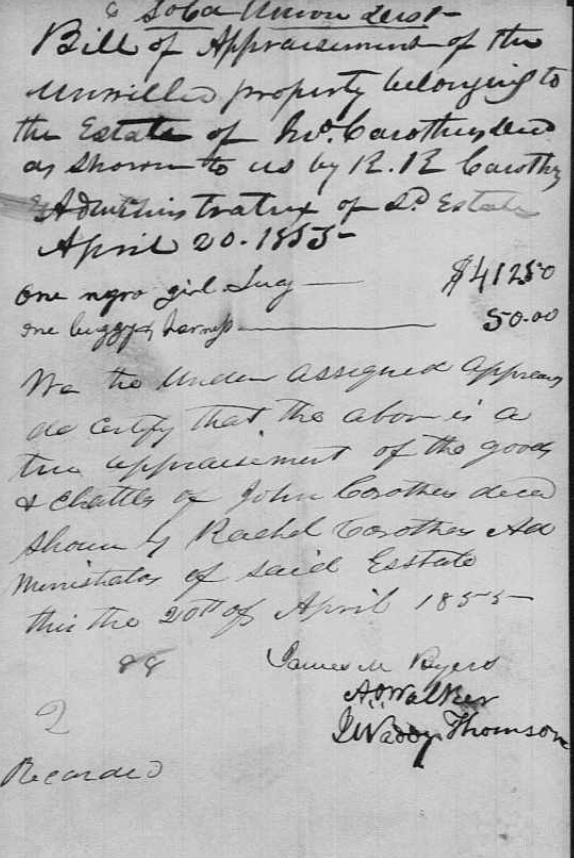
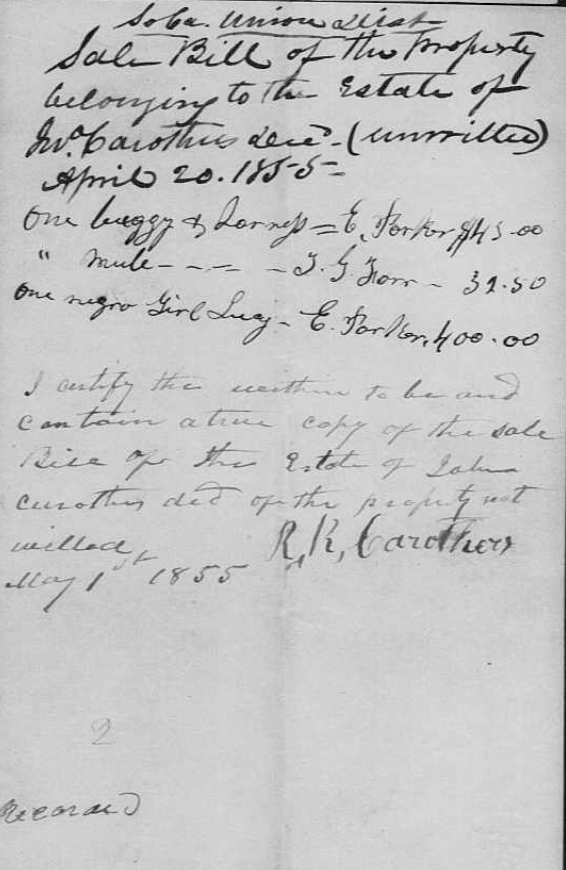
J.F. Walker (James Fowler Walker) (1795-1857) was involved in the estate settlement. He was the father of Samuel Sidney Walker (1826-1890) who married John Carother’s daughter Sallie Carinthia Carothers (1832-1908).
J. F. Walker bought the enslaved man Burrel, making installment payments, the first being June 30, 1855.
J. F. Walker penned his Last Will and Testament in 1850, and there were seventeen names of the enslaved contained within. There was mention of Henry twice, and Lucy. I do not know if this enslaved man and woman were the same Henry and Lucy of the John Carothers household.
J. F. Walker died seven years later, in 1857. I believe that the enslaved man Burrel was back in the Rachel Carothers household by 1860, and I know for certain that he was there in 1865.

I still had not found Emanuel Fowler previous to the 1870 census, yet I did not stop looking for him. I decided to look in the Freedman Bureau’s records to see if there was a labor contract for him.
.On December 27, 1865, Rachel Ross Burrows Carothers and Dr. Wade Fowler signed a labor contract with some of their former slaves. These labor contracts were, in my opinion, slavery under a different name. One only has to read a single contract to see how strict and oppressive the terms were for the newly freed men and women. They were often required to work from sunrise to sundown, and often long after darkness had cast its long shadows.
Their backbreaking work days were long; identical to the work they did as slaves. They were given a share of the crops as pay for their work, but their expenses (clothing, shoes, housing, and medical care) were often deducted from their shares.
And, they were not allowed to leave the farm or plantation without permission. To violate any of the harsh terms of the contract resulted in equally harsh punishment. “Freedom” was not really free.
I read each word of the labor contract carefully, and hopefully, and– finally– near the end of the document, was the name and mark of MANUEL .
I had found Emanuel.
The names of the newly freed men and women in the Carothers/Fowler labor contract were as follows:
- Burrel
- MANUEL……...EMANUEL!!!!!
- Peter
- Maria
- Susan
- Laura
- Sina
- Amanda
- Sam
- Archie
- Jim
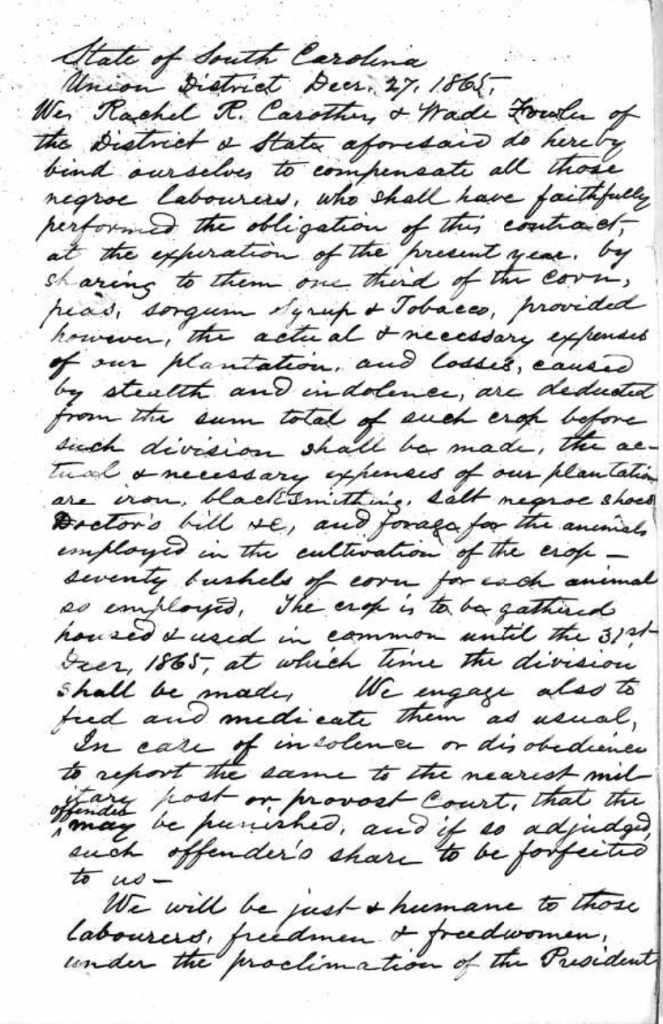

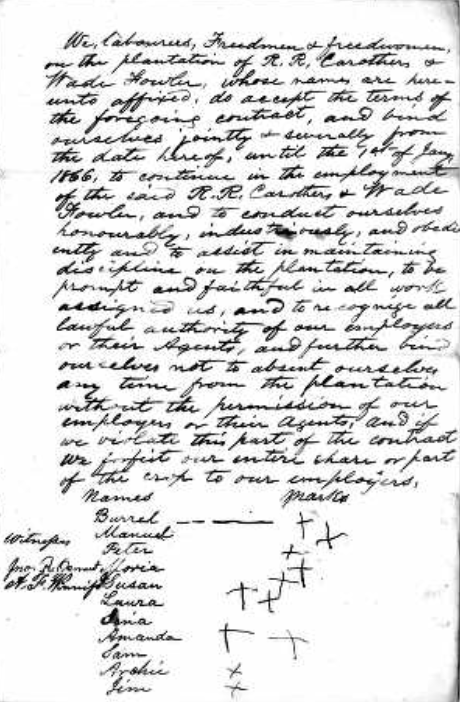
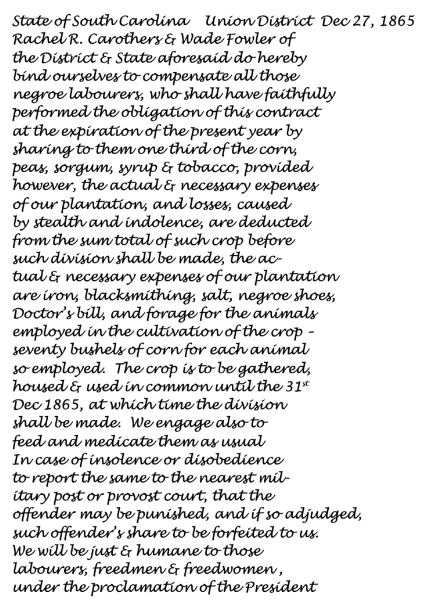
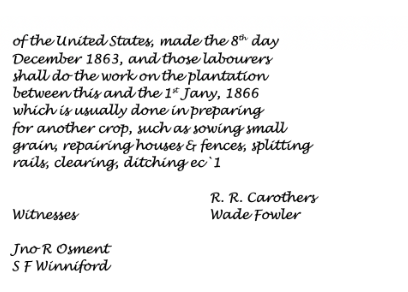

So, who was Emanuel Fowler? I have analyzed the Last Will and Testament of John Carothers, the 1850 and 1860 Slave Schedules for Godfrey Fowler, James Fowler, Milligan Fowler, Wade Fowler, John Carothers, Rachel Carothers, and most of the children of John Carothers. I have studied the estate settlement of John Carothers, and the Last Will and Testaments of anyone and everyone associated with these families.
At this moment in time, my theory — admittedly unproven — is that Emanuel was the twenty-year old enslaved male in the 1850 household of James Fowler, father of Dr. Wade Fowler. At the death of James Fowler in 1857, Emanuel went to the home of the doctor.
I also believe that it is possible that Emanuel could have been a son of James Fowler, and a half-brother of Dr. Wade Fowler. I have even less evidence to back up this theory, but there are certain circumstantial events that make my thoughts lean in this direction. Only DNA testing will clear this up.
I often put my research work into charts and graphs in order to get a clear image in my mind of the tangled relationships of the people from the past. I am including the graph I used for this body of work. The colors (pink, blue, orange, red) indicate family groups — a mother and her children. All of the dates of births are estimates based on the little evidence I was able to find. When there is a name, that was a definite fact. The sex and age brackets that have been put next to a name for all Slave Schedules are guesses only; again, based on some evidence but likely not 100% accurate. This chart may help you understand my research:
Knowing now that Emanuel was an enslaved male in the household of Dr. Wade Fowler, I began searching for snippets of his life. He was recorded in census records of 1870, 1880, 1900, and 1910. He had three wives and fathered perhaps seventeen children. He did not leave the Goudeysville/Draytonville area of Union County (and later Cherokee County), but he had children and grandchildren who traveled and lived far from the old homestead.
Emanuel Fowler was the father of W. Cardozo Fowler (b. 1871). There was legal trouble in 1890 involving Emanuel, Cardozo, Samuel Sidney Walker, and Mr. Daniel Lawson Gallman. Clippings from the April 11, 1890 Union Times and April 9, 1890 Yorkville Enquirer:
I am in the process of researching, and have been somewhat successful, in finding out what happened to many of the other enslaved man and women in the John Carother, Rachel Carother, and Wade Fowler households. I feel this is important to my Emanuel Fowler research as I believe that many were blood related.
I traced several of these enslaved souls to Marshall County, Mississippi, and this slightly confounded me at first. When I realized that some of the children of John Carothers and his first wife had moved to that state, it all began to make sense.
I shall not go into all of the lives of all of the enslaved in this article. I will save that information for another day.
I will also write extensively of the descendants of Emanuel Fowler at a later time. He had many children, and they had many children, and their story needs to be told.
In the meantime, I leave you with the wives and children of a man who spent his first thirty years enslaved, but who –through the Grace of God and Abraham Lincoln –threw off the chains of oppression and lived the last years of his life a free man: Emanuel Fowler.
married Susan Fowler (b. 1835)
- Samuel Fowler (b. 1854)
- Joseph Fowler (b. 1861)
- Hetty Fowler (b. 1864)
- John E. Watson Fowler (b. 1867)
- W. Cardozo Fowler (b. 1871)
married Minerva Fowler (b. 1853)
- Susan Fowler (b. 1879)
married Ida Rice 1865–
- Wade Fowler (1880–1958)
- Ophelia Fowler (b. 1884)
- Liddie Fowler (b. 1889)
- Venus Fowler (1891–1984)
- Jessie Fowler (b. 1892)
- Bessie Fowler (b. 1895)
- Eugenia Fowler (b. 1898)
- Ola Fowler (b. 1899)
- Ellis Fowler (1901–1983)
- Ben Fowler (b. 1904)
- Francis “Frank” Fowler (1906–1965)











Fowler all I can say is WOW! As I slowly scrolled thru the email that this post came in I felt such emotion, as if I was transported there and it felt sacred somehow, this work you are doing.It will take me awhile to get thru it because I don’t want to miss a thing, in your research, just Wow, Fowler. the world needs this. I love the way you write …ty
LikeLike